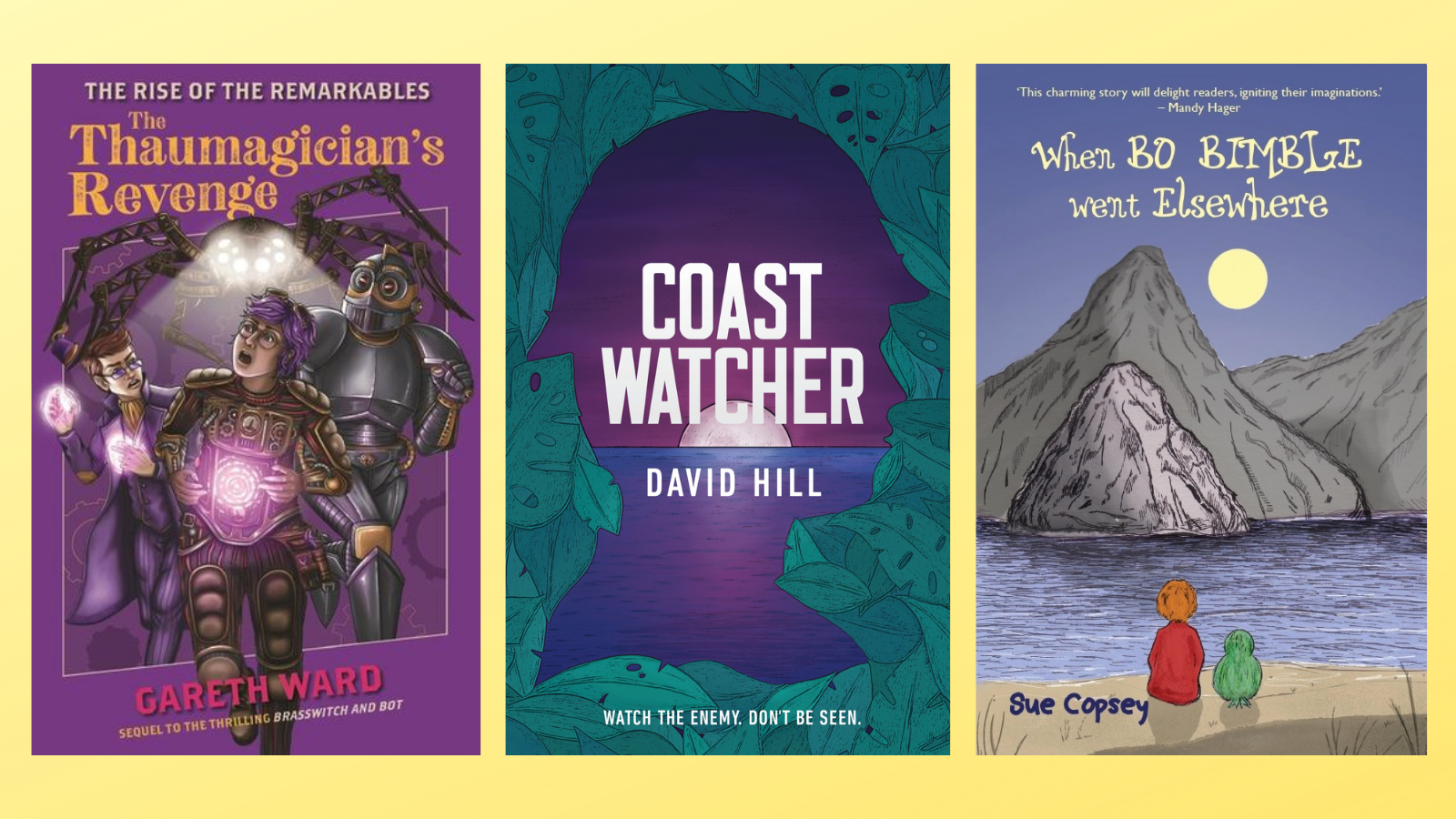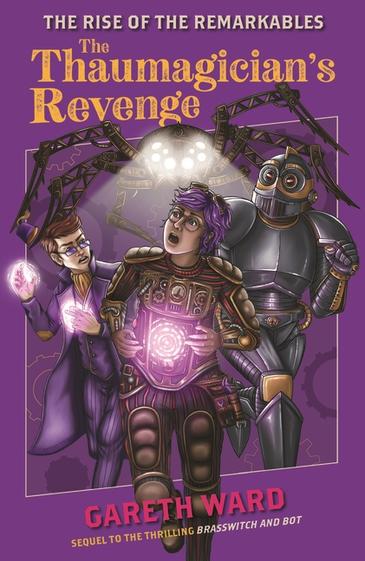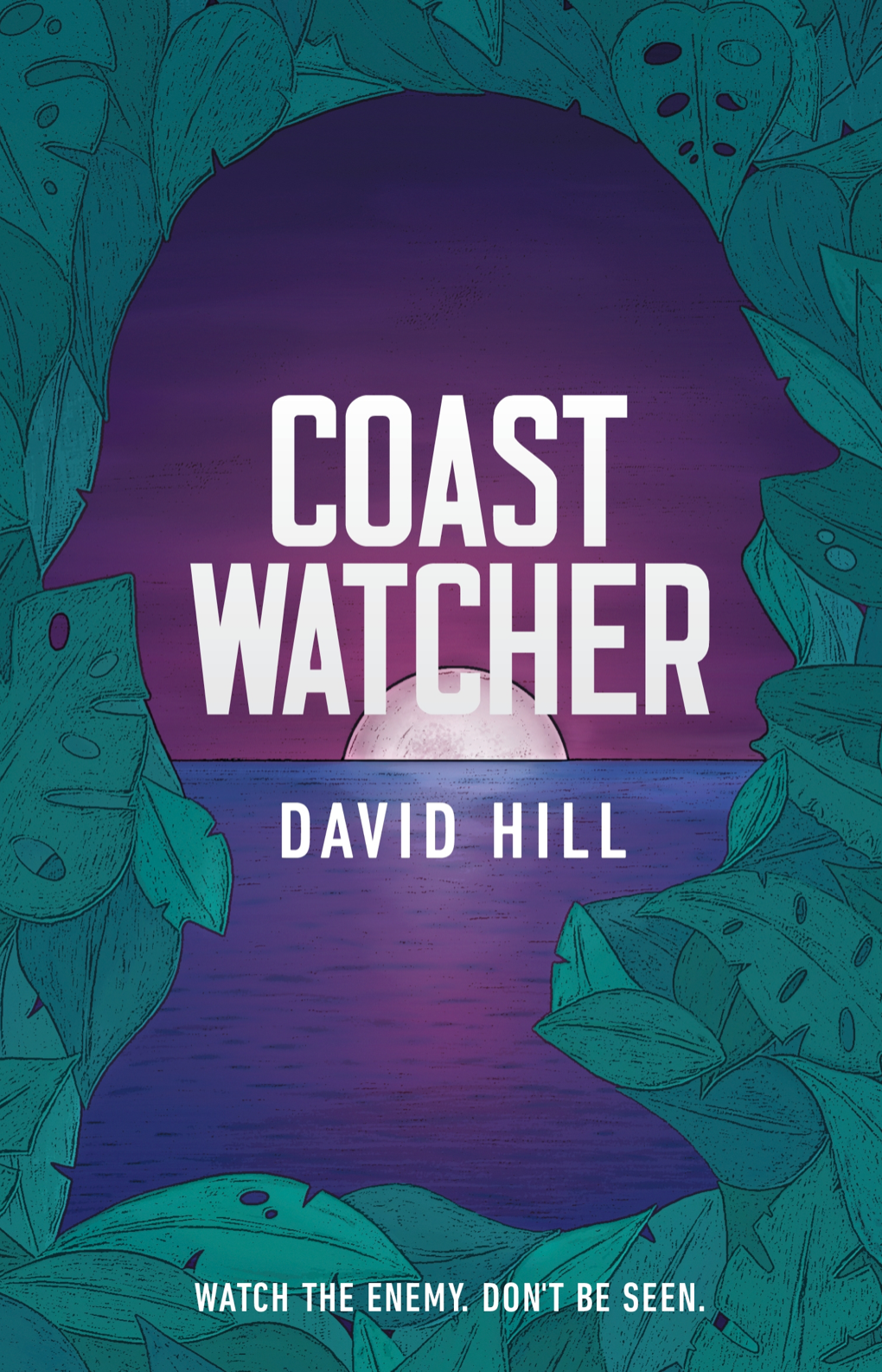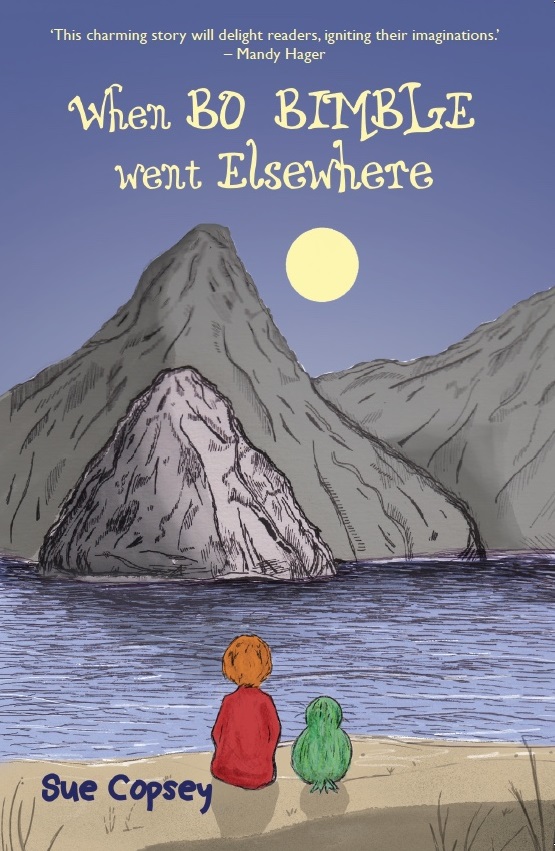Steampunk, historical fiction and mythology? Whatever makes you tick, there’s a serving of fresh new Aotearoa fiction to get you excited. These titles range from junior fiction to young adult fiction, but as with any book, so much depends on the individual kid in question. So read on and see what Editor Sarah has to say!
At time of publication, Aotearoa is at Covid-19 Alert Level 4. Note that any purchases made from the links provided will not be dispatched until after the Covid-19 Alert Level decreases to a level where Aotearoa’s bookshops are operational again.

The Rise of the Remarkables: The Thaumagician’s Revenge, by Gareth Ward (Walker Books)
Do read the first The Rise of the Remarkables book—Brasswitch and Bot—before picking up this wonderfully crafted second part of the trilogy of books by Gareth Ward.
The Thaumagician’s Revenge, like the first, is set in a world where regulator Cabal Thirteen, a group of remarkables (humans with unusual abilities / fusions) are trying to save a world from an evil thaumagician called Plum. Once one of theirs, Plum was shown to be evil at the end of the first book, and attempted to create the Rapture, an opening for old gods to return—something our main character Wrench, who is a witch with power over metal, prevented.
Plum is now looking elsewhere to remove the problem of humans that refer to his type as aberrations, and he’s gathered an army of remarkables around him as he collects the ingredients he needs to create a new creature—one that is only interested in killing humans. But Wrench and Bot can’t get support from the group of regulators led by Captain Flemington, who doesn’t believe remarkables belong in the regulators.
Plum is now looking elsewhere to remove the problem of humans that refer to his type as aberrations…
Along with Wrench and Bot and their friends Octavia and Mister Tranter (a brain in a jar), we have a new character called Vexanna, a thaumagician who can fade between planes of reality, which gets Wrench out of some tight spaces several times. Unfortunately, of course, the other plane of reality has things that shriek and bite, that are particularly attracted to Wrench.
I enjoy Gareth’s books for their cracking dialogue and the incredible creations he peppers them with. He also has a talent for bringing out the humour of the most unusual situations. While they are questioning a hostage, Wrench thinks “It really was hard to go full psycho when sipping tea with lemon from bone china, and she doubted the man’s commitment.”
I enjoy Gareth’s books for their cracking dialogue and the incredible creations he peppers them with.
The plot is a difficult one to summarise quickly. It’s about, I guess, the danger of underestimating those who are different. Wrench has to make tough decisions to keep her and her friends safe, and occasionally has to kill those who would kill her. It’s also about standing by the power of your convictions, even in the face of danger.
We also learn more about how Wrench’s parents died and meet the father of the person who was responsible. Wrench finds out more about her powers with Vexanna’s help, and becomes a more powerful brasswitch—or something else—than ever. When reading it, you are transported to another world, and that’s something we need now and then.
When reading it, you are transported to another world, and that’s something we need now and then.
I was surprised that the narrative didn’t wrap up at the end of the book, but I’m more than happy to read a third book of Bot and Wrench’s attempts to save the world. Recommended for age 11+, mainly due to the complexity of language and plot and frequent nastiness.

The Rise of the Remarkables: The Thaumagician’s Revenge
By Gareth Ward
Walker Books
RRP $22.99
Coastwatcher, by David Hill (Puffin)
Did you know that as the US hunted down Japanese soldiers in the Pacific Ocean, platoons of soldiers including those from Australia and Aotearoa were placed to help defend and spy from Pacific outposts, including Solomon Islands? David Hill has brought us the story of Operation Pacific in his latest in an unconnected series of war-themed middle fiction titles.
19-year-old radio operator Frank Benson isn’t strictly meant to be seeing any action, having been accepted into the army after several attempts to enlist, after being very ill with tuberculosis. He is at the right place at the right time, when he gets ordered, along with fellow Kiwi Wally Ropata and Australian soldier Les Murray, to act as a coastwatching radio operator on an small, uninhabited island overlooking Bougainville.
The character of Frank is thoroughly drawn and entirely believable. He is torn between wanting to ‘do his part’, and recognising that war isn’t a desirable place to be, realising people are people no matter their race. Wally is familiar—I feel like David has written about him before, but perhaps I’m wrong!—and interactions between Wally and Les cause Frank to understand how dangerous racism is.
He is torn between wanting to ‘do his part’, and recognising that war isn’t a desirable place to be, realising people are people no matter their race.
David does a fantastic job of describing the changing environment in which the men were forced to camp. “For half an hour, there was nothing in the world but the roaring storm. Then it stopped. Someone turned off a tap and shut a door in the sky, and the night was still once more. Stars began to glitter. Birds and insects began to tell one another what dreadful weather they were having.”
When the men spot somebody, it turns out to be an islander named A’ata, who has been sent by his village on the mainland to gather food from the island on which they are stationed. Though they aren’t sure they can trust him, they realise the man speaks English, thanks to education at the Church School on Bougainville.
A’ata explains that his people are in the centre of a war not of their making, and have no sides, wishing only that the war would end so they can be at peace. After relaying information about him to HQ, they meet him again, and agree to go to his island to meet his village elders. The Aussie soldier doesn’t trust them entirely, and race has a little to do with this, but the two kiwis persuade him that it is the best way to gain information.
A’ata explains that his people are in the centre of a war not of their making, and have no sides, wishing only that the war would end so they can be at peace.
There’s just one thing I felt could have been better handled, and this is simply the classification of the ‘Nips’ in a stereotypical manner. Not only were there several references to the Japanese troops of all being of one mind, but the word Nips is a racist generalisation. I realise that writing historical fiction means anchoring us in the language of the time, but one recognition of a Japanese soldier as a loved and loving human just like us isn’t quite enough.
I realise that writing historical fiction means anchoring us in the language of the time, but one recognition of a Japanese soldier as a loved and loving human just like us isn’t quite enough.
Overall, I enjoyed this read as a historic rollback into a war of the past, which deals sensitively with the Solomon Islanders impacted against their will. It’s a great tale of heroics without the accompaniment of death and destruction which often of necessity marks war tales.

When Bo Bimble went Elsewhere, by Sue Copsey
When Bo Bimble went Elsewhere tells the story of a mythical Aotearoa bird/creature who wants to know why. She lives in Bimble Sound, and has a continual list in her mind of questions her parents and friends can’t answer. While bimbles can’t fly, having instead developed opposable thumbs, her friends can, and Tom the Tomtit helps her to meet a kiwi, who takes her to Kuia the Tuatara who gives her some wisdom which she interprets as ‘go to the city.’
The first half of the tale is interspersed with the diary entries of a Scottish boy named Bernie, an only child who has been travelling Aotearoa with his parents for many weeks. He is a keen birdwatcher, and notes the birds he has observed in his diary, and names his favourites for the day. At the end of each chapter, there is a page with an image of a New Zealand bird, its name in English and Māori (sadly, prioritising English), and an explanation of the bird and its habitats and characteristics.
He is a keen birdwatcher, and notes the birds he has observed in his diary, and names his favourites for the day.
Both characters, and all of the adjacent characters—particularly the naughty kea Kev and Ken—we really well explored. We got to understand the world of the bimbles without too much world-building dump, and I found myself completely believing that greenberries make you go invisible and if you eat them, let you hear what creatures other than humans are saying!
My personal favourite moment in the book was when Bernie is making his case to his dad to be able to go to the ‘touristy’ luge and gondola in Queenstown, listing every forest walk and mountain climb they’ve been on in the past weeks. When I was 13, I went to the UK with my parents and I felt similarly aggrieved that I didn’t get to do anything that was actually for kids—just the ABC (another bloody cathedral/castle) tour.
Bernie’s care of Bo, and understanding that if she was “discovered” by adults would see her placed in a sanctuary and subjected to endless tests, was really lovely. Bernie is a very good role model for other young boys who enjoy nature.
Bernie is a very good role model for other young boys who enjoy nature.
This book is a bit of a hard one to classify in terms of audience. The front half of it, which has several chapters led with Bo’s voice, is almost at an under-5s level in terms of content. Explaining Bimbles we see “over time, their wings shrank down into little arms, and their wingtip feathers changed into fingers, which as you will know, are very useful.” This and the fact Bo has a really bad case of the “Whys” makes it feel like a good read-aloud for a junior classroom and/or parents reading to under-8s.
The front half of it, which has several chapters led with Bo’s voice, is almost at an under-5s level in terms of content.
However, the chapters which had both Bernie and Bo included, with Bernie as a helpful human that allows Bo to understand the world in which she’s found herself so much better, read much more smoothly and with a more reliable tone. While the drawings of the native birds were good, I found the drawing of the bimbles tricky to relate to Sue’s description of them.
Overall, I’d recommend this book for kids who enjoy fantasy, and young conservationists. It would be good as a mixed-age read-aloud, and a good addition to a junior school library for young readers.


Sarah Forster has worked in the New Zealand book industry for 15 years, in roles promoting Aotearoa’s best authors and books. She has a Diploma in Publishing from Whitireia Polytechnic, and a BA (Hons) in History and Philosophy from the University of Otago. She was born in Winton, grew up in Westport, and lives in Wellington. She was a judge of the New Zealand Book Awards for Children and Young Adults in 2017. Her day job is as a Senior Communications Advisor—Content for Te Herenga Waka—Victoria University of Wellington.



